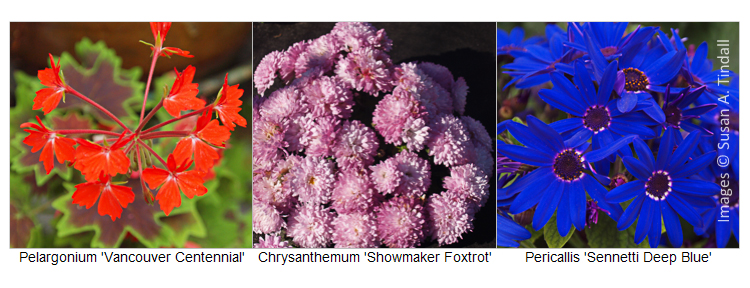Permanently potted
Evergreen plants that you retain in pots can provide a solid framework for the transient plants that are grown for the summer as well as giving interest in winter. Good examples of such plants include the shiny solid evergreen Skimmia, for example Skimmia japonica subsp. Reevesiana with its red autumnal berries, though this needs acid soil and is often grown as a throwaway. Dwarf Nandinas such as Nandina domestica ‘Fire Power’ have coloured foliage for year-round interest and are slow-growing. Variegated Euonymus fortunei forms such as Euonymus fortunei ‘Emerald Gaiety’ are cheap and always cheerful, top-notch container plants. Finally, the bay laurel Laurus nobilis can be pruned like topiary and its leaves can be used in cooking. A true container classic.
Why plant in containers?
- To add style to outdoor spaces or seating areas.
- To grow plants in soil that suits their needs, either because of poor or almost non-existent soil in some new builds, a different soil type is needed such as ericaceous compost or to give respite care to plants that have failed in the garden before trying them in another position
- To enable plants to be taken under cover in winter. For example some plants that are treated as annuals are tender perennials and will survive if wintered in a frost free environment. This applies to Pelargoniums (often treated as annuals), such as Pelargonium ‘Vancouver Centennial’
- To readily move plants to different locations, perhaps when their season of floral beauty has finished.
- To grow plants you can take with you when you move.
Choosing containers
Harmonise your pots. If you have a number of containers the design effect is improved if they are visually united by a shared characteristic. They may all be earthenware, or have the same colour, e.g. blue, or have a similar shape or style.
Movability and cost
Traditional earthenware or terracotta pots develop character with age, but they can be difficult to move. When buying a pot consider its eventual weight when filled with compost and a plant. Really large containers are best not moved, and are best planted in situ. Consider pots where removable containers can be inserted for changeable seasonal plantings. Otherwise nurture accommodating friends with muscle power! There is an ever increasing range of synthetic pots that have simulated stone or metal finishes which are very light.
Container shapes
Consider the type of plant that you want to grow. There are ‘throwaway’ and permanent plants. Throwaways are plants that are discarded after a short period. Typical throwaways include autumn flowering ‘garden mums’ such as Chrysanthemum ‘Showmaker Foxtrot’, or in spring ‘Senetti’ like Pericallis x hybrida Senetti Deep Blue, as well as summer annuals.
If you are growing ‘permanent’ plants which should last for years it is often desirable to ‘move them on’ to bigger receptacles when they outgrow their pots. In this case, avoid containers that curve inwards at the top or which have a rounded centre, since it can be almost impossible to extract plants without damaging them.
Preparing your pot
There should be drainage holes in the pot’s base. This can be protected with a stone or broken crock, or consider fine plastic mesh or even perforated zinc. In this case not only is the earth kept in but small slugs and woodlice will be unable to set up house in the pot bottom.
For all but the smallest pots it pays to put in a layer or stones or pebbles in the base to facilitate drainage. Otherwise water can linger in sodden soil and plant roots can rot.
Use good quality compost and allow for around 3 centimetres of space all round the existing root ball when selecting your pot.
The compost should finish a few centimetres below the pot rim. The surface can be left as earth or covered with pebbles, gravel or slate chips. This prevents moderately fierce applications of water from blasting holes in the compost, or spattering unsightly blobs of earth onto the foliage.
Maintenance
Potted plants need watering regularly, daily in hot weather. Acid-loving plants need soft water (rainwater) so consider a water butt.
The nutrients in the containerised soil will be used up in weeks. It will be necessary to feed your plants, slow-release fertilisers being easiest. With feeding and pruning, some plants can be left in the same container for years. However, buying ‘small’ plants and exercising patience can be a good way to eventually obtain specimen plants at a fraction of the cost.
Some plants will lean towards the light and develop an ungainly lean, or get leggy, so it may be necessary to turn or move pots at intervals.
Enjoy your pots!
Susan A. Tindall


